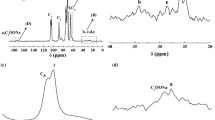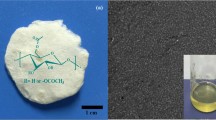Abstract
Nanocomposite hydrogels based on cellulose nanofibrils (CNFs) and poly(acrylic acid-co-acrylamide) were synthesized via in situ free radical polymerization in an aqueous suspension of CNFs. Effects of the inclusion of CNFs with content up to 10 wt% on the swelling properties at different pH and on the compression strength were investigated. The presence of CNFs was shown to strongly reinforce the hydrogel without deteriorating its elasticity. Nanocomposite hydrogel with a content of 10 % CNF supported respectively a strength and deformation about 13 and 2 times higher than that of the neat hydrogel. This effect was explained by the grafting of polymers on the CNFs surface, contributing to an increase in the effective crosslinking density, and improving the interfacial adhesion between polymer chains and CNFs. Moreover, the addition of CNF enhanced the water holding capacity of the hydrogel and caused the system to release urea simulating a fertilizer in a more controlled manner than that with neat hydrogel.










Similar content being viewed by others
References
Abdul Khalil HPS, Davoudpour Y, Islama MN, Mustapha A, Sudeshd K, Dungania R, Jawaid R (2014) Production and modification of nanofibrillated cellulose using various mechanical processes: a review. Carbohydr Polym 99:649–665
Ahmed EM (2015) Hydrogel: preparation, characterization, and applications: a review. J Adv Res 6:105–121
Buyanov AL, Gofman IV, Revel’skaya LG, Khripunov AK, Tkachenko AA (2010) Anisotropic swelling and mechanical behavior of composite bacterial cellulose–poly(acrylamide or acrylamide–sodium acrylate) hydrogels. J Mech Behav Biomed Mater 3:102–111
Demitri C, Scalera F, Madaghiele M, Sannino A, Maffezzoli A (2013) Potential of cellulose-based superabsorbent hydrogels as water reservoir in agriculture. Int J Polym Sci Article ID 435073
Elouali FZ, Maschke U (2011) Kinetics and equilibrium swelling properties of hydrophilic polymethacrylate networks. Macromol Symp 303:71–77
Gong JP (2010) Why are double network hydrogels so tough? Soft Matter 6:2583
Haraguchi K (2011) Stimuli-responsive nanocomposite gels. Colloid Polym Sci 289:455–473
Haraguchi K, Takehisa T (2002) Nanocomposite hydrogels: a unique organic-inorganic network structure with extraordinary mechanicals, optical and swelling/De-swelling properties. Adv Mater 14:1120–1124
Huang T, Xu H, Jiao K, Zhu LP, Brown HR, Wang HL (2007) A novel hydrogel with high mechanical strength: a macromolecular microsphere composite hydrogel. Adv Mater 19:1622
Isogai A, Saito T, Fukuzumi H (2011) TEMPO-oxidized cellulose nanofibers. Nanoscale 3:71–85
Kalia S, Boufi S, Celli A, Kango S (2014) Nanofibrillated cellulose: surface modification and potential applications. Colloid Polym Sci 292:5–31
Lin N, Huang J, Dufresne A (2012) Preparation, properties and applications of polysaccharide nanocrystals in advanced functional nanomaterials: a review. Nanoscale 4:3274
Rose S, Dizeux A, Narita T, Hourdet D, Marcellan A (2013) Time dependence of dissipative and recovery processes in nanohybrid hydrogels. Macromolecules 46:4095–4104
Roy D, Cambre JN, Sumerlin BS (2010) Future perspectives and recent advances in stimuli-responsive materials. Prog Polym Sci 35:278–301
Salas C, Nypelö T, Rodriguez-Abreu C, Carrillo C, Rojas OJ (2014) Nanocellulose properties and applications in colloids and interfaces. Curr Opin Colloid Interface Sci 19:383–396
Siepmann J, Peppas NA (2012) Modeling of drug release from delivery systems based on hydroxypropyl methylcellulose (HPMC). Adv Drug Deliv Rev 64:163–174
Spagnol C, Rodrigues FHA, Pereira EGB, Fajardo AR, Rubira AF, Muniz EC (2012) Superabsorbent hydrogel composite made of cellulose nanofibrils and chitosan-graft-poly(acrylic acid). Carbohydr Polym 87:2038–2045
Tomar RS, Gupta I, Singhal R, Nagpal AK (2007) Synthesis of poly (acrylamide-co-acrylic acid) based superabsorbent hydrogels: study of network parameters and swelling behaviour. Poly PlastTech Eng 46:481–488
Vartiainen J, Pöhler T, Sirola S, Pylkkänen L, Alenius H, Hokkanen J, Tapper U, Lahtinen P, Kapanen A, Putkisto K, Hiekkataipale P, Eronen P, Ruokolainen J, Laukkanen A (2011) Health and environmental safety aspects of nanofibrillated cellulose. Cellulose 18:775–786
Vikman M, Vartiainen J, Tsitko I, Korhonen P (2015) Biodegradability and compostability of nanofibrillar cellulose-based products. J Polym Environ 23:206–215
Watt GW, Chrisp JD (1954) Spectrophotometric method for determination of urea. Anal Chem 26:452–453
Yang J, Han CR, Duan JF, Ma MG, Zhang XM, Xu F, Sun RC (2013a) Synthesis and characterization of mechanically flexible and tough cellulose nanocrystals–polyacrylamide nanocomposite hydrogels. Cellulose 20:227–237
Yang J, Zhao JJ, Xu F, Son RC (2013b) Selective photoredox using graphene-based composite photocatalysts. ACS Appl Mater Interfaces 5:12960–12967
Yin L, Fei L, Cui F, Tang C, Yin C (2007) Superporous hydrogels containing poly(acrylic acid-co-acrylamide)/O-carboxymethyl chitosan interpenetrating polymer networks. Biomaterials 28:1258–1266
Zhang Y, Nypelö T, Salas C, Arboleda J, Hoeger IC, Rojas OJ (2013) Cellulose nanofibrils: from strong materials to bioactive surfaces. J Renew Mater 3:195–211
Zhou C, Wu Q, Yue Y, Zhang Q (2011) Application of rod-shaped cellulose nanocrystals in polyacrylamide hydrogels. J Colloid Interface Sci 353:116–123
Author information
Authors and Affiliations
Corresponding author
Rights and permissions
About this article
Cite this article
Mahfoudhi, N., Boufi, S. Poly (acrylic acid-co-acrylamide)/cellulose nanofibrils nanocomposite hydrogels: effects of CNFs content on the hydrogel properties. Cellulose 23, 3691–3701 (2016). https://doi.org/10.1007/s10570-016-1074-z
Received:
Accepted:
Published:
Issue Date:
DOI: https://doi.org/10.1007/s10570-016-1074-z




